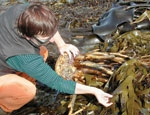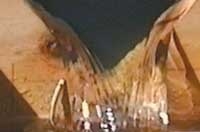PDF of this article (208 KB)


Algal researcher Tracy Farr has been known to take her work home – and into the kitchen – applying her culinary expertise to laboratory leftovers. She’s well known at NIWA’s Greta Point, Wellington, site for her work with coralline algae and other seaweed. Last January she received wider exposure when National Radio took her to the beach to discuss her seaweed recipes on Summer Report. So, what’s cookin', Tracy?
W&A – How would you describe your work at NIWA?
Tracy - I'm a phycologist, working with NIWA’s National Centre for Aquatic Biodiversity and Biosecurity, predominantly on macroalgae. I work on a range of projects, each involving different species of seaweed. I manage the Macroalgal Culture Collection – a seed bank of hundreds of cultures of New Zealand seaweeds – and I'm on the coralline algae team. There’s also long hours at the computer: developing and maintaining databases to hold and organise our data; writing papers, posters, and books; organising and analysing digital images.
The best part of my job, though, is fieldwork. It’s all shore-based, and all intertidal, which means we wait for a low tide and go and fossick in the tide pools and shallows for seaweed. I've travelled all around the country doing seaweed fieldwork, including trips to the Chatham Islands, Stewart Island, and Fiordland, and I never get tired of it. These field collections are what drive much of our research, so they're a critical part of our work.
W&A – What drew (or led) you to this career?
Tracy - I've taken a circuitous path to get where I am. I went to school and university in Perth, Australia, where I did a science degree (honours in microbiology) straight out of school, and followed that up with a BA in English, more or less for fun.
Originally I worked mostly in biomedical research, on things like immunology and virology (HIV and other virus research), protein interactions, pesticide resistance in caterpillars, DNA sequencing. When I saw a seaweed job advertised at Te Papa, I thought, "Yes, that’s the science job I've always wanted!", and I was able to translate my skills into a package that got me the job. In 2002, my research group moved from Te Papa to NIWA, although we still have strong links with Te Papa.
W&A – What does the coralline algae team do?
Tracy - Kate Neill, Wendy Nelson, and I work together as a team. Coralline algae are red algae that are calcified – they look a little like coral, or pink rock – and they're important because they produce chemical signals that induce paua and other animals to settle. Corallines are notoriously difficult to work with and have been little studied in the past, but we've had generous funding from the Ministry of Fisheries over the last three years to document the common coralline algae of central New Zealand.
Last year we held a coralline identification workshop for people like DOC workers, university researchers, and museum staff. We've just published an identification guide, which we're delighted with, and which we think will be a great resource for a whole range of people from seaweed experts to students to resource managers. MFish has funded us for a further three years to look at coralline algae in northern New Zealand; we started that fieldwork programme in July, making collections in the Auckland area.
W&A – How did your work feature at the recent Association for Women in the Sciences conference?
Tracy - A few years ago, senior photography students from Massey University (supervised by Anne Noble) undertook a project which paired photographers with scientists to produce a photographic and word essay about the scientist. The aim was to show that scientists aren't all middle-aged blokes in lab coats with pocket protectors. I was chosen as a subject. High-school students were the target audience. The project – called Re-Visioning Science – was funded by the Royal Society, and was displayed at the AWIS conference this year. It’s been shown at schools around the country. The result of the project is very beautiful – like a magical treasure box or bookcase with each essay folded into a large matchbox, and the matchboxes all lined up, ready to be discovered.
W&A – So what really happened at the beach last summer?
Tracy - Wendy and I turned up at the Chocolate Fish café, armed with a chilly bin full of fresh seaweed and dishes we'd each cooked the night before, to meet Anna Tait-Jamieson from National Radio. There was a howling southerly, and we were hoping that we'd sit in the warmth and chat over coffee, but Anna marched us down to the beach and perched us on the rocks to record the piece. We had to crouch down behind the rocks to shelter the microphone from the wind, and regularly stop recording as planes flew overhead, but we got it done in the end.
Note: This wasn't Tracy’s first time on the air. In addition to her other talents, she’s a published author of short stories, five of which have been read on National Radio. She’s yet to publish a cookbook, but for those who want to try her seaweed recipes, here’s one to begin with.
Baked karengo with garlic and orange juice

- Wash fresh karengo in fresh water, and pick over the blades to remove any sand and small animals. Pinch off and discard the holdfast (point where seaweed attaches to rock), and either tear the blades into palm-sized pieces or shred them more finely with a knife.
- Place the karengo in a shallow ovenproof dish and drizzle with olive oil. Sprinkle with a crushed clove of garlic and the juice of an orange, and toss to mix.
- Bake at 180 degrees for 20 minutes (thicker blades may take longer) or until the lower layers in the dish are softened, with a slightly crispy finish to the top.
